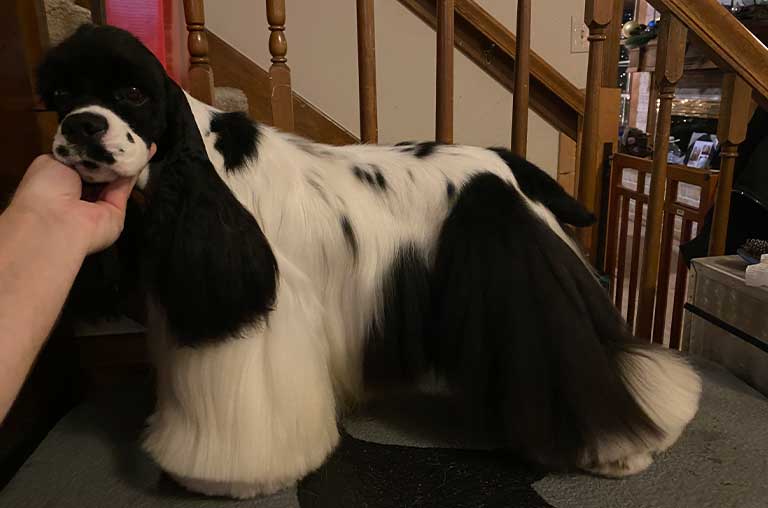Dogs in general have a variety of body language with which they use to communicate with their owners. Understanding these body languages is all you need to answer the question “What is Your Cocker Spaniel Telling You?” Understanding your cocker spaniel`s body language is an essential part of connecting with your cocker spaniel, and a crucial aspect of safe and responsible ownership. At the end of this article, you’ll know how to effectively communicate with your Cocker Spaniel if you understand your dog and do some observation. All Cocker Spaniel owners will enjoy this educational experience. Just follow me to the end.
Cocker Spaniel Body Language and Vocalizations
The basic body languages of a cocker spaniel dog are the movement of the ears, eyes, eyebrows, head, tail, and mouth. Cocker Spaniel’s whining, barking, and growling are examples of vocal signs. The meaning of these gestures might change throughout time, including dog panting. This could signal that the dog is anxious, hot, or simply happy. Sometimes, this body language might be confusing. It could be also in direct opposition to what the same gesture means to humans, including yawning or turning away.
Now, let`s take a close look at each of these postures and what your cocker spaniel is actually telling you!
Tail Wagging
Isn’t it true that a dog’s tail wags when it’s happy? Wrong. This signal is frequently misinterpreted. A wagging tail simply indicates is simply telling you that your cocker spaniel is emotionally stimulated. This could be joy, as well as it could also be an annoyance or even worse off. At this point, it is crucial to examine the pace and direction of your dog`s wag, and the posture of its tail, to discern the level of your dog’s emotions and intents. The faster your cocker spaniel wags its tail, the more excited it is. And when the tail wag is slow, long, and weeping side-to-side, this means the dog is relaxed. Have you noticed a dog on guard and very alert? The tail wagging thing is a good sign to check if a dog likes someone or not. This feature can be useful if you’re choosing a walker for your Cocker Spaniel, the dog will wag it’s tale in a good pace if he likes the walker.
Raised Hackles

Whenever your dog’s hackles come up, it signifies his back hair is standing up. The hair can firm up across its forearms, down his/her back, and all through the tail. This is a condition known as piloerection. This is a clear indication that your cocker spaniel is excited, though not definitely in a bad way. The dog could be sad or stressed, but he/she could equally be delighted or have an interest in something. It’s typically an uncontrollable reaction, similar to when individuals get goosebumps.
The Dog`s Posture
The weight distribution of your dog can reveal a lot about its attitude and intent. Consider a dog that was stooped over and pawing at the ground. This is a symptom of anxiety or stress. The dog’s position makes him appear smaller as if he’s attempting to run off from something. In many cases, Cocker Spaniel does that when they doesn’t like leash attached.
The dog may equally be saying, “I don’t mean any harm.” The most extreme version of this stance is a dog rolling on its back and displaying its belly. It might equally mean that the dog is asking for a belly rub. However, it might also be an indication of significant stress. In order to pacify the dog, he may even urinate a little.
Facial Expressions
Cocker spaniels have facial features that are comparable to those of humans, but they just do not utilize them likewise. They can equally be telling you something with their facial expressions. If they are not comfortable in their bed it can be shown in their expression like tucked ears and tails, raised hackles, lip-licking, and panting. Those signs show that you’ve not chosen the best dog bed.
Consider the act of yawning. Dogs yawn each time they’re agitated, while people yawn each time, they’re sleepy or bored.
Cocker spaniels yawn to calm down themselves in difficult situations and to soothe others, including their masters, according to the author of
“On Talking Terms with Dogs: Calming Signals”,(Turid Rugaas).
She recommends that it is a good idea to yawn at your cocker spaniel. This will bring comfort to your dog during stressful situations such as a doctor’s appointment. However, you should not be surprised to see your cocker spaniel yawn back in response. Yawns are contagious in dogs, just like they are in people.
Sometimes during exercising in the sun due to the heatwave your Cocker Spaniel might feel discomfort so it will be visible in their expression as well.
State of The Eyes

Cocker spaniel also uses their eyes to speak to their owners. Looking at your dog’s eyes might reveal a lot about his or her internal state. The eyes of a dog might be soft or steely. The soft eyes of your dog have relaxed lids. Because of this, they appear to be squinting at times.
These imply how calm and relaxed the dog is and also content. And hard eyes, on the other hand, appear to become frigid. These are signs of a bad mindset, and you’ll recognize them whenever you set eyes on them. However, your cocker spaniel could be protecting its toy or acting aggressively. A hard gaze, in which the dog stares intensely at something for an extended period of time, usually indicates a threat.
Conclusion
Dog language is a complete package. None is complete without the other or has any effect on their own. When reading your cocker spaniel`s body language, pay attention to every other sign that he/she uses, from his/her tail height to the shape of his/her eyes.
Your dog is always telling you something. If you understand what your cocker spaniel is saying each time, he/she is talking to you, you will create a deeper sense of respect and trust with your cocker spaniel. By understanding your cocker’s body language you can know your cocker spaniel’s temperament and personality.

Leave A Comment